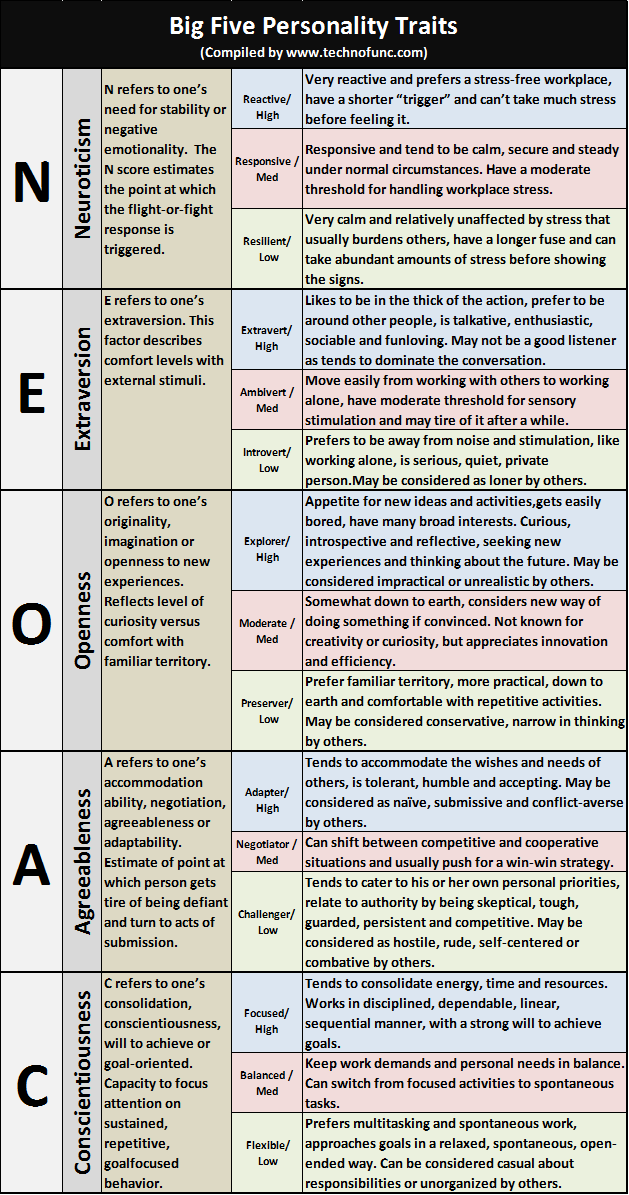- Home
- Business Processes
- Industry Knowledge
- Aerospace Industry
- Automotive Industry
- Banking Domain
- BFSI Industry
- Consumer/ FMCG Industry
- Chemicals Industry
- Engineering & Construction
- Energy Industry
- Education Domain
- Finance Domain
- Hospitality Domain
- Healthcare Industry
- Insurance Domain
- Retail Industry
- Travel and Tourism Domain
- Telecom Industry
- Leadership Skills
- eLearning
- Home
- Leadership
- Leadership Theories
- Five-Factor Personality Model
Five-Factor Personality Model
Five Factors Model (FFM) also known as Five-Factor Personality Model is based on five broad personality traits which are extraversion, neuroticism, openness to experience, agreeableness, and conscientiousness represented by acronym OCEAN, these traits are often referred to as the “Big Five”.
What are Big Five Personality Traits:
Over the past 25 years, a consensus has emerged among researchers regarding the basic factors that make up what we call personality. Psychologists now believe that of all the various methods for classifying personality dimensions, only one stands out as the most statistically robust: the Big Five. These factors, commonly called the Big Five, are neuroticism, extraversion, openness, agreeableness and conscientiousness.
N = Neuroticism = Need for stability, negative emotionality
E = Extraversion = Positive emotionality, sociability
O = Openness = Originality, imagination
A = Agreeableness = Accommodation, adaptability
C = Conscientiousness = Consolidation, will to achieve, goal-oriented
Table below provides the description, attributes and explanations for each of the factors listed above. These five personality factors are the most reliable for differentiating personality traits. The Big Five synonym clusters appear to account for most differences among individual personalities, describing five universal dimensions. We score a high, low or mid-range rating in each dimension and interpretations of the scores is given below:
|
Big Five Personality Traits |
||||
|
N |
Neuroticism |
N refers to one’s need for stability or negative emotionality. The N score estimates the point at which the flight-or-fight response is triggered. |
|
Very reactive and prefers a stress-free workplace, have a shorter “trigger” and can’t take much stress before feeling it. |
|
Responsive / |
Responsive and tend to be calm, secure and steady under normal circumstances. Have a moderate threshold for handling workplace stress. |
|||
|
Resilient/ |
Very calm and relatively unaffected by stress that usually burdens others, have a longer fuse and can take abundant amounts of stress before showing the signs. |
|||
|
E |
Extraversion |
E refers to one’s extraversion. This factor describes comfort levels with external stimuli. |
|
Likes to be in the thick of the action, prefer to be around other people, is talkative, enthusiastic, sociable and funloving. May not be a good listener as tends to dominate the conversation. |
|
Ambivert / |
Move easily from working with others to working alone, have moderate threshold for sensory stimulation and may tire of it after a while. |
|||
|
Introvert/ |
Prefers to be away from noise and stimulation, like working alone, is serious, quiet, private person.May be considered as loner by others. |
|||
|
O |
Openness |
O refers to one’s originality, imagination or openness to new experiences. Reflects level of curiosity versus comfort with familiar territory. |
|
Appetite for new ideas and activities,gets easily bored, have many broad interests. Curious, introspective and reflective, seeking new experiences and thinking about the future. May be considered impractical or unrealistic by others. |
|
Moderate / |
Somewhat down to earth, considers new way of doing something if convinced. Not known for creativity or curiosity, but appreciates innovation and efficiency. |
|||
|
Preserver/ |
Prefer familiar territory, more practical, down to earth and comfortable with repetitive activities. May be considered conservative, narrow in thinking by others. |
|||
|
A |
Agreeableness |
A refers to one’s accommodation ability, negotiation, agreeableness or adaptability. Estimate of point at which person gets tire of being defiant and turn to acts of submission. |
|
Tends to accommodate the wishes and needs of others, is tolerant, humble and accepting. May be considered as naïve, submissive and conflict-averse by others. |
|
Negotiator / |
Can shift between competitive and cooperative situations and usually push for a win-win strategy. |
|||
|
Challenger/ |
Tends to cater to his or her own personal priorities, relate to authority by being skeptical, tough, guarded, persistent and competitive. May be considered as hostile, rude, self-centered or combative by others. |
|||
|
C |
Conscientiousness |
C refers to one’s consolidation, conscientiousness, will to achieve or goal-oriented. Capacity to focus attention on sustained, repetitive, goalfocused behavior. |
|
Tends to consolidate energy, time and resources. Works in disciplined, dependable, linear, sequential manner, with a strong will to achieve goals. |
|
Balanced / |
Keep work demands and personal needs in balance. Can switch from focused activities to spontaneous tasks. |
|||
|
Flexible/ |
Prefers multitasking and spontaneous work, approaches goals in a relaxed, spontaneous, open-ended way. Can be considered casual about responsibilities or unorganized by others. |
|||
Study to Examine Big Five Personality Dimensions:
To assess the links between the Big Five and leadership, Judge, Bono, Ilies, and Gerhardt (2002) conducted a major meta-analysis of 78 leadership and personality studies and found a strong relationship between the Big Five traits and leadership.
This model of leadership was result of a study to examine the relationship between the “Big Five” personality dimensions (neuroticism, conscientiousness, extraversion, agreeableness, and openness) with respect to career success. A sample of few hundred employees was surveyed in a diverse set of occupations and organizations. Hierarchical regression analysis was used to examine the incremental variance contributed by the five personality traits after controlling for several career-related variables.
Results showed that, extraversion was related positively to salary level, promotions, and career satisfaction and that neuroticism was related negatively to career satisfaction. Agreeableness was related negatively only to career satisfaction and openness was related negatively to salary level. It was confirmed as expected that having certain personality traits is associated with being an effective leader.
Is the Big Five personality assessment valid?
Researchers have pointed to reliability studies that are consistent enough to approach the status of law and for the corporate world; this model provides a reliable, standard vocabulary with which to discuss personality differences. Although the Big Five model gives us a uniform language based on standard definitions, but the fact remains that a combination of forces shape an individual. The Five Factors can be thought as being the main infrastructure as human individuality is too complex for any one system to explain adequately.
This personality assessment can be practically applied to identify the needs of a specific role prior to selecting or appointing a leader and performing a match of factors to determine success of the individual in the role.

Related Links
You May Also Like
-
Strategic Contingencies Theory is a theory of intra-organizational power. The power of a subunit or individual depends on a few contingencies and that the more contingencies are controlled by a subunit, the greater is its power. The theory focuses on tasks that need to be done in the form of problems to be solved, thus de-emphasizing personality.
-
David Kolb produced this popular model for learning in 1984. The model suggests four stages of learning which most learners go through in order to learn effectively. Leaming is itself a process of change. Something is added to our perception and prepared us for the next impression, which will change our understanding yet more, however minutely. The Kolb contribution is a significant one because it practically equates change and learning.
-
University of Iowa Studies was the first leadership study to analyze leadership using scientific methodology. The study was conducted by Lewin, Lippitt, and White and worked on different styles of leadership. The studies explored three leadership styles - authoritarian, democratic, and laissez-fair leaders. This early study was very influential and established three major leadership styles.
-
The style approach emphasizes that one style of leadership behaviour cannot be effective in all situations. Earlier theories treated leadership exclusively as a personality trait and behavior approach has widened the scope by including the behaviors of leaders and what they do in various situations. Explore how you can benefit from the concepts to understand your own behaviors and what are some of the leadership tools based on the style approach to leadership.
-
Leadership traits refer to personal qualities that define effective leaders. Here are the major leadership qualities that can make someone a good leader. Five key traits that are common in leaders can be learned and sharpened with time.
-
The Systemic Approach to Leadership
The systemic approach to leadership looks at the organization as a whole and focuses on the understanding of the organization as a system. Moving to systems thinking demand managers to view organizations as organic systems. Leaders are also part of this complex system which is constantly undergoing change and evolving. The leaders need to manage the relations and networks within these systems by acting with systemic awareness.
-
Contingency Theories of Leadership
Contingency theories of leadership focus on both the leader's persona as well as the situation/environment in which that leader operates. These theories consider the context of leadership which means whether or not the leadership style suits a particular situation and states that a leader can be effective in one circumstance and a failure in another one. A leader will be most effective when he applies the right leadership style to a given situation and environment around him. Contingent leaders are flexible and adaptable.
-
The Fiedler Model of leadership is a contingency theory and states that a leader's effectiveness is based on the situation. There is no one best style of leadership and the effectiveness of a leader in an organization depends on matching the leader to the situation. Leaders should determine the natural leadership style and assess the situation to flex the style.
-
Charismatic leadership is a trait-based leadership theory where the leaders act as visionary driven by their convictions and motivate their followers to work towards common vision using their charm and persuasiveness. These charismatic leaders act as role models and exhibit extraordinary characteristics that inspire devotion and motivation in followers to persuade change. Leaders are able to cultivate a profound sense of trust with the group of followers.
-
Idiosyncrasy Credit Model of Leadership builds upon the awareness that when the emergent leader meets the team's expectations, idiosyncrasy credits are awarded. These credits depend on how the leader fulfilled follower's expectations and what is the impact of the leader's decisions on the follower. When the balance of credits shifts, another leader will emerge.
Explore Our Free Training Articles or
Sign Up to Start With Our eLearning Courses

About Us
Learning
© 2023 TechnoFunc, All Rights Reserved










